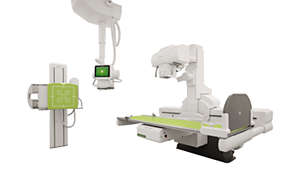Dynamic UNIQUE real-time imaging processing
High-quality representation of diagnostic details in low-dose fluoroscopy
Features

Temporal and spatial noise suppression
Dynamic UNIQUE’s inter-frame (temporal) noise suppression uses temporal averaging, which accumulates the dose of successive frames, to reduce noise in static anatomical structures. When movement is detected, temporal averaging is restrained and spatial noise suppression steps in.
In moving regions, Dynamic UNIQUE applies intra-frame (spatial) noise suppression. The strength of spatial noise suppression is adapted to the strength of temporal noise reduction. As a result, image noise level is kept consistently low over the entire image. There is no lag effect. There are no shadows and no artifacts of moving structures.
Brightness stabilization
Dynamic UNIQUE automatically determines the signal level in the anatomical region and maps it to an appropriate brightness level so you’ll experience comfortable live viewing with immediate brightness stabilization – from the first frame forward. This is less tiring to your eyes, as less time is needed to adapt to the luminosity.

Multi-scale image enhancement
Dynamic UNIQUE delivers excellent detail with overall contrast harmonization – even in challenging viewing conditions. Each and every frame is fully processed in real-time and optimally enhanced. There are no enhancement artifacts. There is no image clipping. So you are less likely to miss important details[1].


Fluoroscopy 7000 N — ProxiDiagnost N90
DRF digital radiography and nearby fluoroscopy solution
Dynamic UNIQUE image processing software delivers consistently uniform clinical image quality for all anatomic regions within one image by automatically adjusting the balance between overexposed and underexposed areas.

More clarity and confidence with Dynamic UNIQUE
Compare side-by-side with conventional image processing and see the benefits for yourself.
Dynamic UNIQUE real-time imaging processing technology is available on
-
CombiDiagnost R90
CombiDiagnost R90 is a remote controlled fluoroscopy system in combination with high-end digital radiography, designed to improve room utilisation in a cost effective manner. A fully digital workflow, UNIQUE image quality and excellent dose management make the versatile system suitable for a wide range of examinations from pediatric to bariatric imaging.
709031
"Dynamic UNIQUE image processing software harmonizes contrast. It also enhances faint details and creates uniform image quality, which enables us to clearly tell the difference between bones and soft tissue."
Dr. Paul Molitor
Radiologist
Centre Hospitalier du Nord, Ettelbrück, Luxembourg
Documentation
- Resources
-
- Clinical articles
-
Footnotes
[1] On routine clinical image data with standard image processing settings





